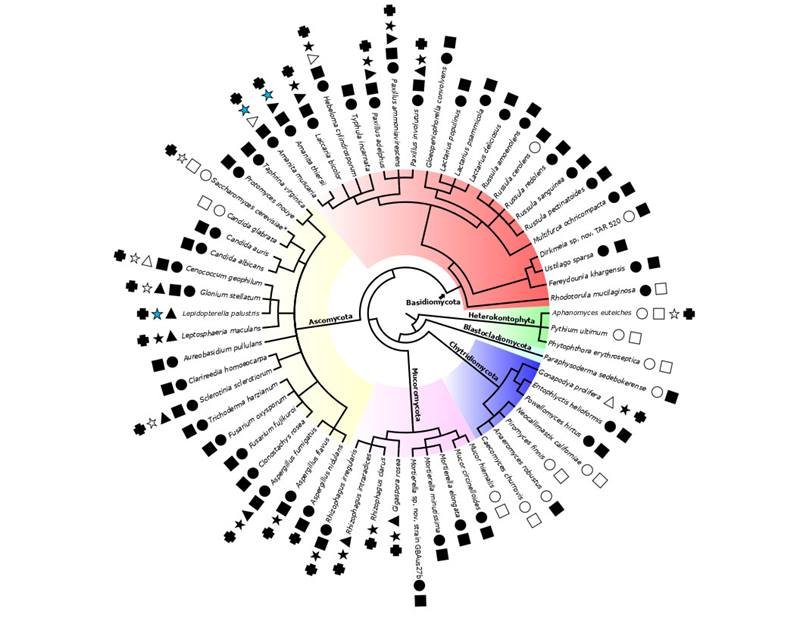08/04/2020
Compound Communicates More than Expected in Microbes
A unique symbiotic signal is more common among microbes than previously believed and causes unexpected behaviors in pathogenic fungi

Black symbols show where scientists discovered the communications compounds called lipo-chitooligosaccharides in 59 species of fungi and three species of oomycetes (water molds).
[Rush, T.A., et al., “Lipo-chitooligosaccharides as regulatory signals of fungal growth and development,” Nat. Comm. 11:3897 (2020). [DOI: 10.1038/s41467-020-17615-5] CC BY 4.0.]
The Science
Communication is critical to every aspect of life. Microbes use chemical signals to exchange information with their plant hosts. These signals initiate symbiotic associations – relationships between different species that are beneficial to at least one. Scientists believe some of these chemical signals are unique and are specialized for specific purposes or audiences, like a coded signal or a foreign language. One example is the compounds called lipo-chitooligosaccharides (LCOs). Researchers previously believed that LCOs are symbiotic signaling molecules for specific fungi. This new research demonstrated that these compounds are actually ubiquitous and effect fundamental growth patterns and behaviors across many types of fungi.
The Impact
This study finds that many fungi produce and use LCOs as chemical signals for communications. This expands the role of these compounds. They are not only for symbiotic signaling in specific partnerships. Instead, the compounds have general significance in regulating the development of fungi. This discovery opens new areas of research on the role of signaling molecules in shaping microbial communities in soil and other complex environments. By better understanding chemical signaling and microbial interactions, scientists can advance bioproduct development and solve environmental challenges.
Summary
Lipo-chitooligosaccharides (LCOs) are signaling molecules that were previously characterized in rhizobial bacteria and arbuscular fungi for their role in triggering symbiotic relationships such as root nodulation and mycorrhizal associations with plants. These new results show that many other fungi, including those with no reported associations with plants, can also produce LCOs. Using functional assays and/or analytical measurements, the researchers tested 59 species across all fungal phyla and found that 53 species produced LCOs. Further, they demonstrated that LCO treatment affects spore germination, hyphal branching, hyphal growth, and transcription in non-symbiotic fungi, such as the opportunistic human pathogens Aspergillus fumigatus, and Candida glabrata. These findings suggest that LCO production is common among fungi, and that LCOs function as signaling molecules that regulate fungal growth and development. Thus, this study suggests that LCOs have diverse functional roles, beyond symbiosis establishment with plants, and are likely important for interspecies competition and for structuring the microbiome.
Principal Investigator
Tomás Rush
Oak Ridge National Laboratory
rushta@ornl.gov
